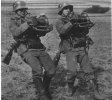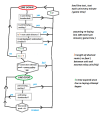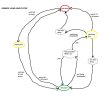Hallo kameraden , could someone enlighten me as to the common practice / procedure for calling in arty during WWII ? Yes I know someone picks up the radio or land-line handset and requests it , but whom do they speak to and how does it get passed on to the relevant artillery unit ?
You are using an out of date browser. It may not display this or other websites correctly.
You should upgrade or use an alternative browser.
You should upgrade or use an alternative browser.
I did my military training as a forward observer so here are my two cents (although more modern). The FO either has preplanned missions on map coordinates or he knows his position and observes the target area and makes the necessary calculations. He then radios that information to where the mortars/artillery is set up. All tubes are carefully aligned in a certain direction. The information from the FO is then translated to how the individual tube should adjust and which load the shell should use as well as the angle of fire (Y-axis). They fire spotting rounds that the FO hopefully can spot. He then, based on his position visavi the target, calls how the spotting round lands, usually something like "short 100 m, left 200 m", which is radioed back. The necessary adjustments is made because the battery knows the FO's position in relation to the intended target. They fire new spotting rounds. If they land on target or close enough the FO calls "fire for effect" and the rest of the mission is carried out. I did my service in a 120 mm mortar platoon and IIRC "on target" meant within a radius of 100 m. Even though that this was in the early 90s and we had some modern radio equipment and calculation assistance, the basic mortar itself was like the ones used in WWII. The most difficult thing in WWII compared to modern era I would imagine would be guessing how wind condition (shells fly really high) will pull the shells off target.
Thank you . Now what happens if you are spotting for a long range gun unit like 175mm for e.g. , and your radio is not in range of that unit ? I am assuming you would have to contact your immediate HQ , who would then have to pass on your request to the gun unit , as the HQ has more powerful radio equipment ?
I would suppose radio messages got relayed between FO-HQ up the command chain-eventually to the site of the battery. That is probably why the procedure for gettning fire for effect for large long range artillery usually is longer.
Ah yes , as I guessed . Just imagine how difficult this must have been in WWII , particularly for a rifle company on foot , in hills / mountains , with adverse weather . I am just thinking out loud hear . Out of interest , what would you guess is a realistic maximum distance for a land-line ? I was just a machine gunner and never paid much attention to those land-line cables strewn around .

You will have a laugh at this - but I have toted wire like that in real life. I absolutely hated it. One of those rolls wouldn't be much more than 500 m IIRC. Then you had to splice the wires together, no guarantee for success there. Crossing roads with traffic, no fun either. The wire was highly suspect to breakdown or poor quality transmission.
I am reading a book on the Bulge and one big problem for the American side in the opening stages was that the German artillery tore land lines apart so the forward troops were effectively cut from their own artillery assets.
I am reading a book on the Bulge and one big problem for the American side in the opening stages was that the German artillery tore land lines apart so the forward troops were effectively cut from their own artillery assets.
Read this book: Bracketing the Enemy: Forward Observers in World War II, by John R. Walker, it will answer most of the questions you have on WW2 artillery, especially from the American perspective.
Be prepared to be shocked at how experienced and effective these soldiers became in its use. Especially surprising for me was how good they got at adjusting, using just their hearing and how much use was made of light aircraft for reconnaissance and spotting. Especially of enemy artillery units.
As for coms, a lot of it was done in WW2 by field telephone (wire) especially in defensive positions. Radio messages can get relayed by other stations if out of range of their own guns.
Sometimes small teams are put in strategic places just for this purpose. On exercises in Norway for example, we has a two man team on the top of one of the mountains for a week, with a pack full of batteries and a hand cranked generator, just relaying fire missions between the valleys.
The artillery radio nets are renowned within the forces for being the best at getting through and for being the best source of information.
https://www.strategypage.com/bookreviews/1009.asp
Be prepared to be shocked at how experienced and effective these soldiers became in its use. Especially surprising for me was how good they got at adjusting, using just their hearing and how much use was made of light aircraft for reconnaissance and spotting. Especially of enemy artillery units.
As for coms, a lot of it was done in WW2 by field telephone (wire) especially in defensive positions. Radio messages can get relayed by other stations if out of range of their own guns.
Sometimes small teams are put in strategic places just for this purpose. On exercises in Norway for example, we has a two man team on the top of one of the mountains for a week, with a pack full of batteries and a hand cranked generator, just relaying fire missions between the valleys.
The artillery radio nets are renowned within the forces for being the best at getting through and for being the best source of information.
https://www.strategypage.com/bookreviews/1009.asp
Last edited:
Dave 'Arjuna' O'Connor
Panther Games Designer
- Joined
- Jul 31, 2014
- Messages
- 3,416
- Points
- 113
- Location
- Canberra, Australia
- Website
- www.panthergames.com
Daz, what's the book called. That link just takes me to the general Amazon shop page.
I was having problems with the link. Have fixed it in the post above now.Daz, what's the book called. That link just takes me to the general Amazon shop page.
Lol , I am guessing that is you on the leftYou will have a laugh at this - but I have toted wire like that in real life. I absolutely hated it. One of those rolls wouldn't be much more than 500 m IIRC. Then you had to splice the wires together, no guarantee for success there. Crossing roads with traffic, no fun either. The wire was highly suspect to breakdown or poor quality transmission.
I am reading a book on the Bulge and one big problem for the American side in the opening stages was that the German artillery tore land lines apart so the forward troops were effectively cut from their own artillery assets.
The book is a dissertation and can be found here: https://etd.ohiolink.edu/rws_etd/document/get/kent1248041184/inline
I think it is a legitimate download.
I think it is a legitimate download.
Wow , thanks rocketmanThe book is a dissertation and can be found here: https://etd.ohiolink.edu/rws_etd/document/get/kent1248041184/inline
I think it is a legitimate download.
 What about this flow chart for determining whether a unit has a viable land-line connection ? All comments welcome View attachment 4423
What about this flow chart for determining whether a unit has a viable land-line connection ? All comments welcome View attachment 4423
Last edited:
Dave 'Arjuna' O'Connor
Panther Games Designer
- Joined
- Jul 31, 2014
- Messages
- 3,416
- Points
- 113
- Location
- Canberra, Australia
- Website
- www.panthergames.com
Thanks Kurt. Good work. Alas I don't think we can afford one route per unit per minute. Perhaps a better test would be to first check to see that the unit was dug in. This occurs after being deployed for 2 hours. Then I think it would be safe to assume you would have had the time to lay all those cables. Also, you need to check up the command chain. You might be dug in and within range of your HQ but it might not be. Rather than a route perhaps we can settle for a flat range.
It might become more relevant when we get the Eastern Front packs or for very early war scenarios but units at this scale (Coy) were hardly ever without coms to the guns. Even if the lines got severed they still had radios to fall back on.
In good weather they had the Air OP's that could conduct the shoots.
If we are going to make it more realistic I would suggest just a very small random chance for lost coms. This just needs to be a random roll whenever you place a bombard marker, modified by the units current organisation maybe?
For the rare occasions when there was no coms with the guns, it could be for many different reasons, cut lines just being a small percentage of that. It could be that both OP parties had been killed, radios destroyed, broken, the FDC destroyed or the guns under counter battery fire as just a few examples. The guns being under counter battery fire is modelled in the game of course, with their suppression.
Its great what you have done, and would be awesome for a game at section level, but with the numerous ways that fire can be directed at the Coy and Bn level I don't think it needs to be modelled that accurately.
What could be looked at though is the intel on the enemy arty batteries. With reference from the reading I have been doing, I think they should be much easier to spot once they have fired, from much greater distances and they should stay spotted for longer to allow the AI to continue to counter battery fire on them during attacks, rather than just a 5 min stonk.
In good weather any moving, or in the open, Arty unit should be spotted to simulate the extensive use of Air OP's.
In good weather they had the Air OP's that could conduct the shoots.
If we are going to make it more realistic I would suggest just a very small random chance for lost coms. This just needs to be a random roll whenever you place a bombard marker, modified by the units current organisation maybe?
For the rare occasions when there was no coms with the guns, it could be for many different reasons, cut lines just being a small percentage of that. It could be that both OP parties had been killed, radios destroyed, broken, the FDC destroyed or the guns under counter battery fire as just a few examples. The guns being under counter battery fire is modelled in the game of course, with their suppression.
Its great what you have done, and would be awesome for a game at section level, but with the numerous ways that fire can be directed at the Coy and Bn level I don't think it needs to be modelled that accurately.
What could be looked at though is the intel on the enemy arty batteries. With reference from the reading I have been doing, I think they should be much easier to spot once they have fired, from much greater distances and they should stay spotted for longer to allow the AI to continue to counter battery fire on them during attacks, rather than just a 5 min stonk.
In good weather any moving, or in the open, Arty unit should be spotted to simulate the extensive use of Air OP's.
Good comments . During the fighting in the Vosges mountains and hills , both Axis and Allies had problems with radios . The Germans in particular had considerable arty available for their offensives , however due to poor comms it was often unavailable . The Germans also had to rely on human " runners " to pass messages back and forth due to the same issues . A random chance of comms failure is a simple , viable option and this could be modeled using the existing COMMS RATING on unit estabs . I like your comments on enemy arty intel and counter-battery fire .
A ( relatively ) quick fix for the comms simulation , based on Daz's advice could be a " Force Comms Setting " for each side , that is set by the scenario designer . With this setting ( 0-100 ) we could reflect not only the overall signals/comms capability of a force but also take into consideration the terrain and weather effects . Any time the human player attempts to place an immediate bombardment onto a target area , the force comms setting e.g. 65 , becomes the probability ( as in 65% ) of that bombardment being allowed . If the random roll produces a " fail " then the bombardment dose not take place and additionally an area ban / block is placed on that map location for a random time period ( 10-60 game minutes for e.g. ) to prevent the human player selecting another arty unit and trying again . Also the selected arty units would be unavailable to the human player for the same time penalty . I think this could help tame the " artillery beast " to some extent . Comments please
It would be good to have some kind of random roll for its availability and some counter battery bombardment. I imagine it would be quite complex to code though. What happens when more than one unit has LOS on the enemy location for example? Maybe there can be a test for LOS on all the units and give a random roll to each?
The other problem is artillery was a "Beast". Take a look at this as an example:
Heavy fighting continued around the village for the next seven or eight days. Artillery played a key
role for both sides. Its near even application resulted in a temporary deadlock. American artillery
helped the defenders hold out, while German guns drove back repeated attempts by the 345th Infantry
to advance through the woods to the north of the village.
Booth later observed: "Artillery in those days helped each side to gain and to lose the village several times. The net result was a fierce and
bloody stalemate. Neither side could 'win' in the face of (the] artillery fire of the other. But use of the
highway was denied to the Germans: our objective."
I think what would help to balance things up, is to make the AI artillery as powerful as it was a few years ago. The problem with this, is not everyone liked the AI that powerful. So I think there needs to be another difficulty setting in the game that varies the AI artillery effectiveness, so everyone can play at the level they prefer. I think this would be the easiest option to implement.
The other problem is artillery was a "Beast". Take a look at this as an example:
Heavy fighting continued around the village for the next seven or eight days. Artillery played a key
role for both sides. Its near even application resulted in a temporary deadlock. American artillery
helped the defenders hold out, while German guns drove back repeated attempts by the 345th Infantry
to advance through the woods to the north of the village.
Booth later observed: "Artillery in those days helped each side to gain and to lose the village several times. The net result was a fierce and
bloody stalemate. Neither side could 'win' in the face of (the] artillery fire of the other. But use of the
highway was denied to the Germans: our objective."
I think what would help to balance things up, is to make the AI artillery as powerful as it was a few years ago. The problem with this, is not everyone liked the AI that powerful. So I think there needs to be another difficulty setting in the game that varies the AI artillery effectiveness, so everyone can play at the level they prefer. I think this would be the easiest option to implement.
Last edited:
Similar threads
- Replies
- 1
- Views
- 1K
- Replies
- 36
- Views
- 5K
